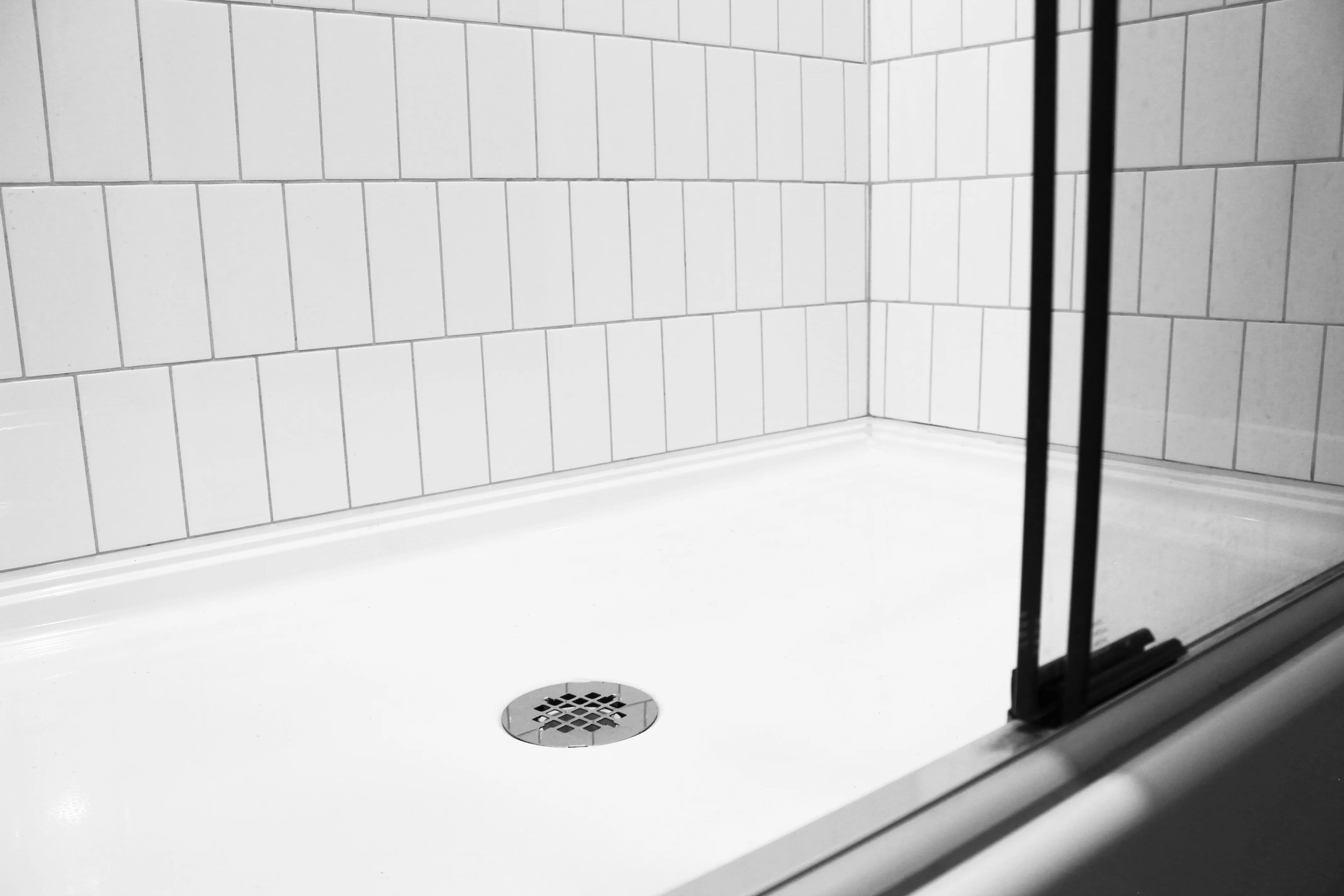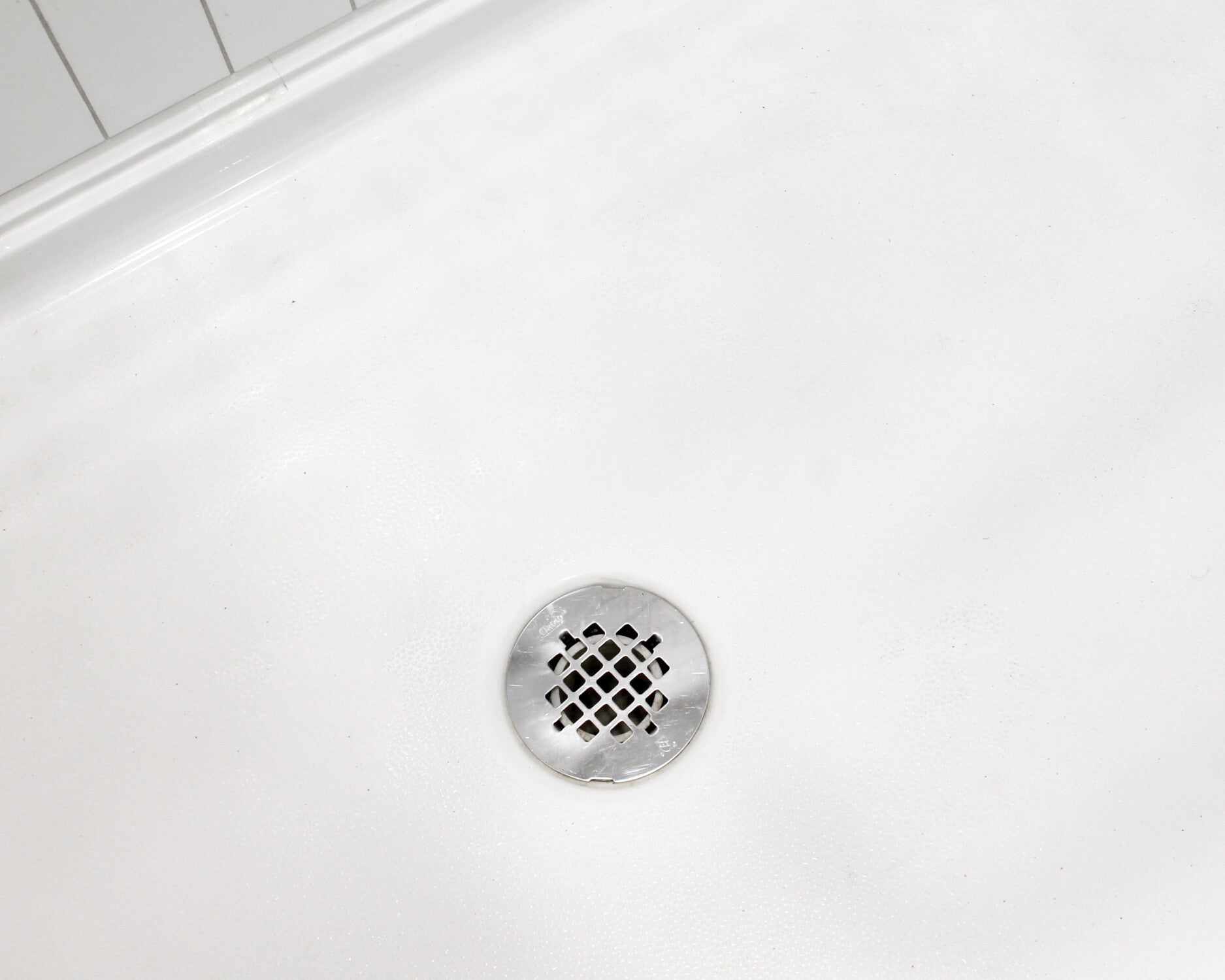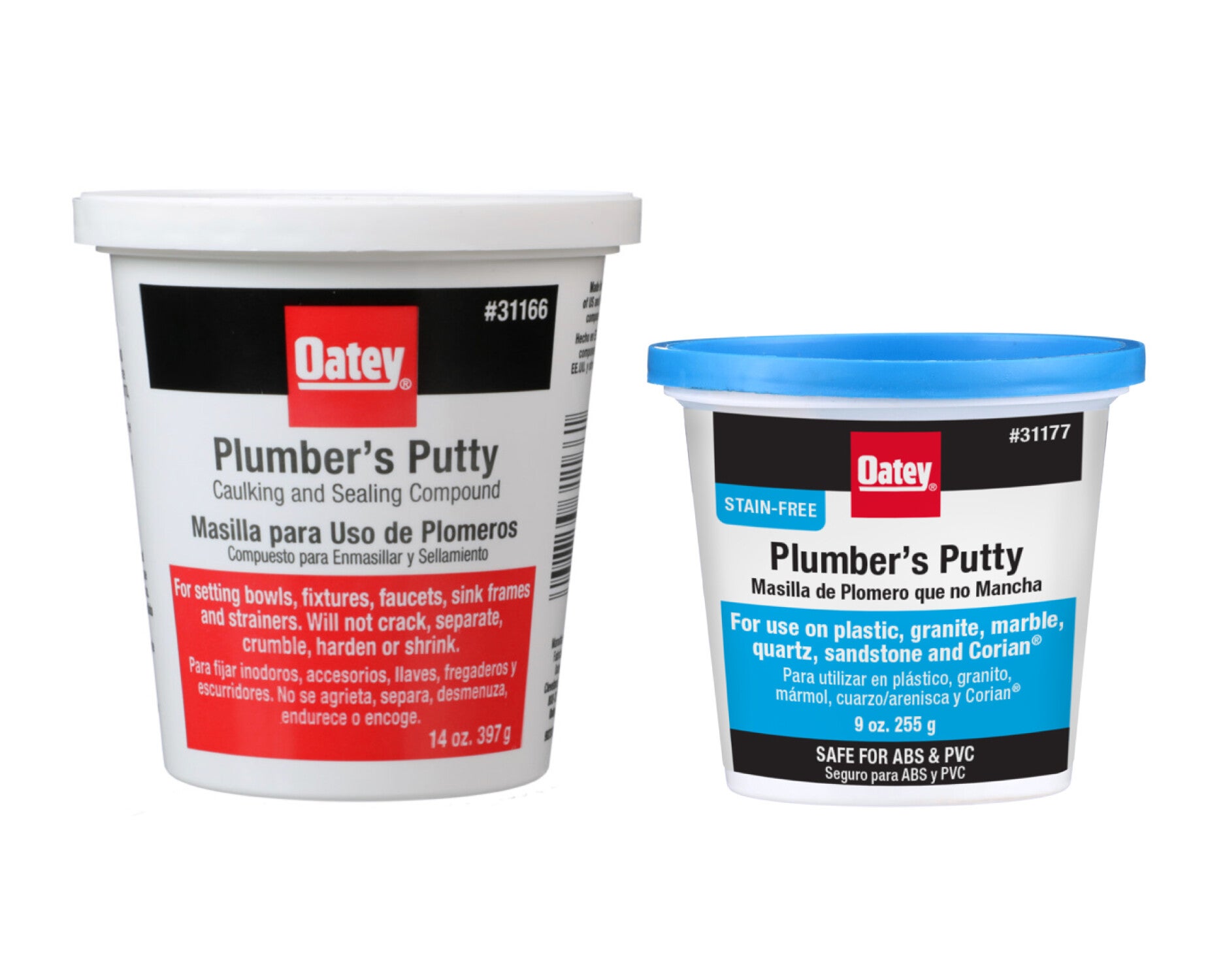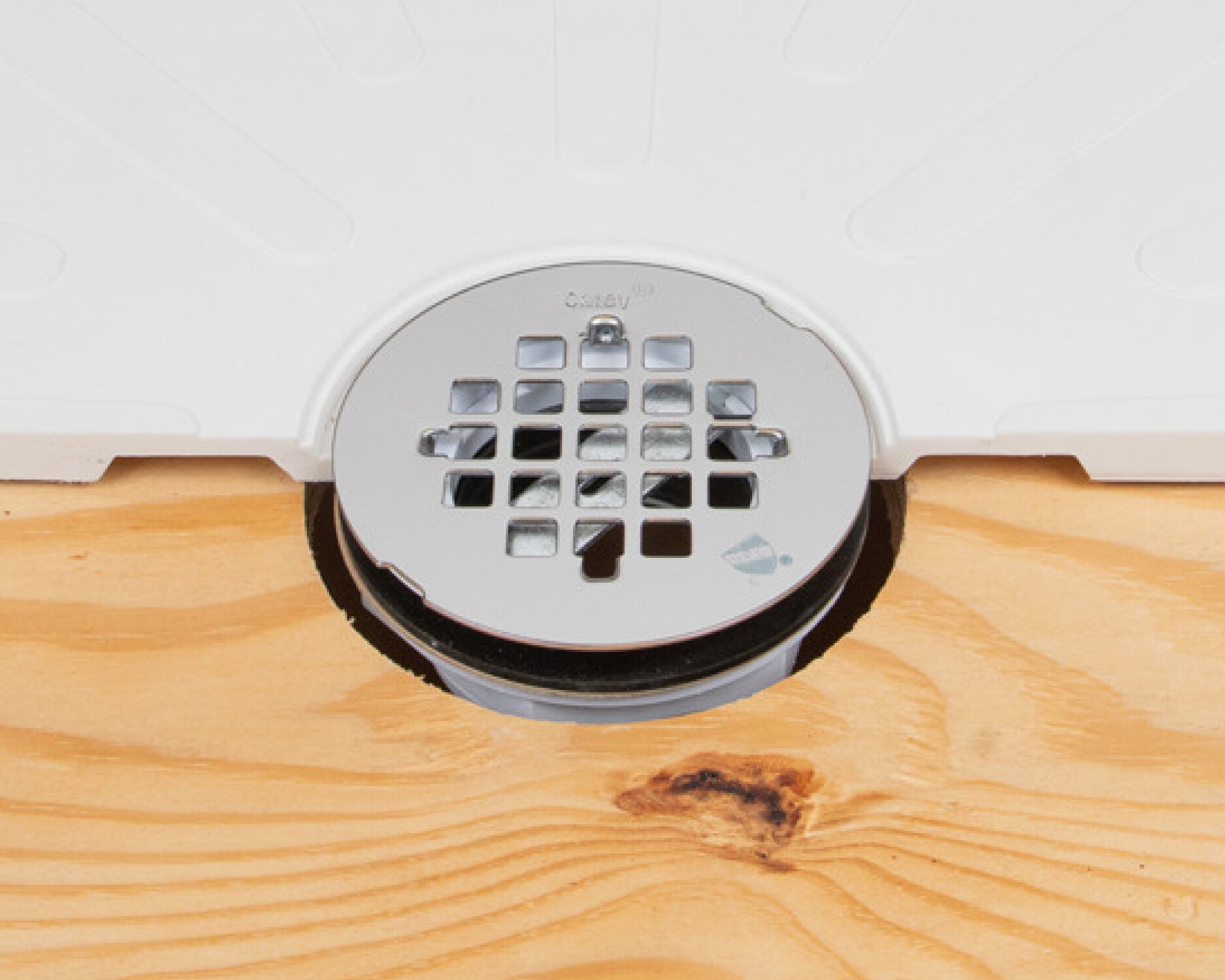If you’re preparing to install an Oatey® Plastic No-Caulk Shower Drain or Brass Shower Drain Assembly, these tips will help you feel confident and ready to tackle your shower drain installation like a pro.
Oatey No-Caulk Shower Drains have a drain body that seals to the shower base with washers. They are designed for use with preformed shower bases and mechanically attach over a two-inch Schedule 40 DWV (drain, waste, and vent) pipe. No lead caulking is required.
Be sure to refer to Oatey’s detailed step-by-step instructions for no-caulk shower drain installations.
1. Understand the Intended Use of Oatey No‑Caulk Shower Drains
Caulkless shower drain products are designed specifically for use with preformed shower stall bases. They are not intended for use in tiled shower floors. If you're installing a drain in a non-preformed shower base, check out the other options available at Oatey.com that better suit your needs.

2. Verify the Size of Your Drain Pipe
Before installation, verify the size of your vertical drain pipe. It should be two inches in diameter. The two-inch No-Caulk gasket provided with the drain assembly creates a watertight seal around PVC, ABS, cast iron, and galvanized drain pipes. (These pipe materials have the same outside dimensions, referred to as Iron Pipe Size, or IPS.)
If your vertical drain pipe is two-inch DWV Copper or 1½-inch IPS, please visit Oatey’s website for information on optional gasket selections.
3. Determine the Material of the Existing Pipe
Before beginning installation, it’s important to identify the pipe material you are working with. This will help determine the type of connection used on the pipe. Five common pipe materials are used in residential plumbing, which can be divided into two categories: plastic and metal.
Plastic Pipes:
Plastic pipes are inexpensive, durable, and commonly found in newer construction. They come in two types that are ideal for residential drains and preferred for their longevity:
- ABS (Acrylonitrile Butadiene Styrene): Typically black.
- PVC (Polyvinyl Chloride): Usually white and widely used for drain systems.
Metal Pipes:
Metal pipes are more commonly found in older homes. There are three types of metal pipes you may encounter:
- Copper: Known for its resistance to corrosion and long lifespan, copper is more expensive than plastic.
- Galvanized steel: Common in older homes, galvanized steel pipes typically have a life expectancy of around 50 years.
- Cast iron: This heavy-duty type is often used in older homes or when noise reduction from running water is desired.
4. Identify the No-Caulk Shower Drain Material
Identify the No-Caulk Shower Drain Material
There are three different Oatey No-Caulk Shower Drain materials available for preformed shower bases. Once you identify the pipe material, you can select the appropriate Oatey No-Caulk Shower Drain and the recommended putty or sealant for installation.
Here are the available variations of Oatey No-Caulk Shower Drains:
- Oatey 2 in. 101 PNC PVC No-Caulk Shower Drain with Stainless Steel Strainer
- Oatey 2 in. 101 PNC ABS No-Caulk Shower Drain with Plastic Strainer
- Oatey 2 in. 101 PNC PVC No-Caulk Shower Drain with Ultrashine® Polished Brass Strainer
- Oatey 2 in. 101 PNC ABS No-Caulk Shower Drain with Stainless Steel Strainer
- Oatey 2 in. 140 NC Brass No-Caulk Shower Drain with Stainless Steel Strainer
For any ABS No-Caulk Shower Drain installation, use Oatey Stain-Free Plumber’s Putty, which is approved for use with ABS materials.

5. Know the Material of the Shower Base
To install a no-caulk shower drain, apply a half-inch bead of Oatey Plumbers Putty around the underside of the no-caulk barrel flange. Identifying the material of your shower base is essential for choosing the right putty or sealant. Oatey Plumber’s Putty is commonly used for No-Caulk Shower Drain installations.
For shower bases made of granite, marble, quartz, sandstone, Corian®, plastic, or other porous materials, use Oatey Stain-Free Plumber’s Putty.
To ensure compatibility between the putty or sealant and your specific shower base material, always refer to the product submittals available on Oatey.com. These guidelines will help you select the right materials to prevent issues and extend the life of your shower drain installation.

6. Determine the Height of the Vertical Drain Pipe
Before installing the shower drain, measure the finished height of the vertical drain pipe to ensure it aligns properly with the No-Caulk Shower Drain. Verifying this before final installation can save you time and effort later.
The vertical drain pipe (the pipe coming up from the floor) should be 3/4” below the top flange of the No-Caulk Shower Drain. “Measuring the finished height” means checking that the top edge of the drain pipe reaches the proper level so the drain will seal properly once the shower floor or pan is in place.
This step is crucial, as an incorrect height—too high or too low—can prevent a proper connection, potentially causing leaks or requiring rework. Taking this measurement upfront helps avoid the hassle of adjusting the drain height after the shower pan is installed, which would be much more complicated.
7. Know the Local Code Requirements
Before starting any project, always check your local building and plumbing code requirements. A permit is typically required for plumbing work to ensure your project will pass inspection. To find the relevant codes, visit your town hall, check your town’s website, or consult your local library for assistance.
Other Tips to Avoid Installation Issues:
- Know the correct order for the washers: Oatey No-Caulk Shower Drains are designed with a drain body that seals to the shower base with washers. The large rubber sealing washer should be placed against the underside of the shower base, with the friction washer positioned between it and the locking nut.
- Chamfer the pipe end: Chamfering the pipe end is highly recommended to prevent damage to the gasket. Chamfering involves removing the sharp edge from the outside of the pipe, which reduces the risk of gouging or cutting into the rubber gasket.
- Know the correct orientation of the No-Caulk washer: The flat side should face down, with the beveled side facing up.
How to Remove the No-Caulk Shower Drain Cover
If you need to remove the shower strainer for cleaning or to refresh its appearance, follow these steps to avoid damaging the strainer during removal:
- Use a screwdriver for the removal.
- Place the end of the screwdriver under the notched area of the strainer.
- Apply light upward pressure while being careful not to damage the finished surface.
- No-caulk shower drain cover should release from the shower base.
If you have any questions or concerns regarding the removal of your strainer, please contact Oatey Customer Service at technical@oatey.com.

Can you caulk a caulkless shower?
No, you should not caulk a "caulkless" shower, as the design is intended to create a watertight seal without the need for additional caulking. Applying caulk could potentially disrupt the intended functionality and may even cause leaks by trapping water in unintended areas.
Should you caulk around the shower drain?
Yes, you should generally caulk around a shower drain to prevent water leaks, mold growth, and ensure a proper seal around the drain opening. It's considered a good practice to seal this area with a waterproof caulk like silicone sealant.
Is it better to use silicone or plumber's putty on a shower drain?
For a shower drain, it is generally better to use silicone instead of plumber's putty, as silicone is more water-resistant, durable, and less likely to crack or deteriorate over time when constantly exposed to moisture in a shower environment.
What holds a shower drain in place?
A shower drain is typically held in place by a combination of a rubber sealing washer, a friction washer, and a locking ring that screws onto the drain flange. These components are tightened against the underside of the shower base, usually with a bead of silicone caulk or plumber's putty applied around the flange to create a watertight seal.
What does "no-caulk shower drain" mean?
A no-caulk shower drain is a drain that attaches to a preformed shower base without the need for lead caulking. Instead, the drain is sealed to the pipe using a compression gasket or rubber gasket.
How do caulkless showers work?
Caulkless showers work by using specially designed interlocking panels that click together tightly, creating a watertight seal without the need for traditional caulk around the seams.